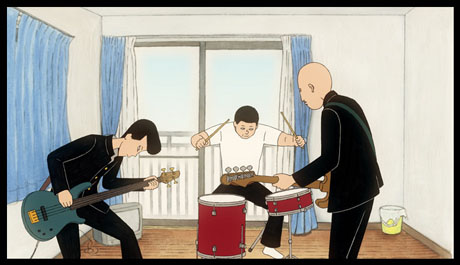
Kenji Iwaisawa’s offbeat On-Gaku: Our Sound (2019) has attracted a loyal following in the US; it even earned an Annie nomination for Independent feature. Although it’s based on a self-published manga by Hiroyuki Ohashi, Iwaisawa wrote the screenplay, directed the film and animated it almost single-handedly. He simply couldn’t afford professional animators; the film’s shoestring budget was raised through crowd-funding.

On-Gaku (“music” in Japanese) focuses on three delinquents at Chiku High School known as “the Three Musketeers.” Bald, chain-smoking Kenji is the leader of the thugs; Ota sports a pompadour that recalls Fabian c.1959; rounding out the group is Asakura, a hulking lunk. This unprepossessing trio sets out to fight Oba, the head bad boy at rival Marutake Technical High. Unable to find the nearby school, Kenji and his chums return home. Out of the blue, he suggests they form a band.
Kenji’s idea sounds even more improbable than Mickey Rooney urging Judy Garland, “Let’s put on show!” Kenji, Ota and Asakura have no training, no knowledge of music and no talent. They can barely distinguish a regular guitar from a bass. When they jam, Kenji and Ota play the same note over and over and over, while Asakura bangs the drums like a wind-up toy monkey.
The results can barely be described as music, but the trio delightedly decides to call their band Kobujutsu, after an old Okinawan martial arts tradition Ota’s uncle practiced. They discover a folk-rock trio on campus already calls themselves Kobijutsu (a Japanese term for ancient works of art) and seek them out. Although he’s genuinely talented, Morita, the long-haired leader of Kobijutsu, is enthralled by the delinquent threesome’s performance, hailing the raw power of rock and roll in it. He persuades Kenji and his sidekicks to perform with them at the upcoming Sakamoto Town Rock Festival.
As soon as Kenji agrees to play at the festival, he loses interest in the whole business and quits the band. Ota and Asakura don’t know what to do; Aya, the curly-haired bad girl Kenji likes, insists he’ll come around.

En route to the festival, Kenji encounters Oba and his posse, all of whom sport Mohawks. Rather than beat them up, Kenji dodges them, whips out a recorder and performs an elaborate series of melodic riffs. With Koba’s gang in hot pursuit, he tootles his way to the festival. He joins Kobujutsu-Kobijutsu on stage and wows both the audience and the other performers with a display of musical virtuosity neither they nor the viewer imagined he possessed.
Much of the fun in On-Gaku comes from the way it revels in its cheapness. The extremely simple character designs, with their minimal features and oddly outlined eyes, look more like refugees from an early episode of Beavis and Butt Head than anything in contemporary anime.
As the “Behind the Scenes” mini-documentary shows, Iwaisawa filmed his friends performing the characters’ actions, printed the frames and traced them onto cels: Rotoscoping without a rotoscope. As a result, the movements are limited and often strange-looking. The walks feel as weightless and awkward as anything in an silent “Farmer Alfalfa” cartoon–and the characters walk around a lot, having nothing better to do. The screen often goes dead as Iwaisawa holds on a single cel for several seconds.
On-Gaku: Our Sound is by no means a great film, but it has a subversive punk energy that sets it apart from more polished but formulaic features on both sides of the Pacific.
- Charles Solomon’s Animation Year End Review 2023 - December 28, 2023
- INTERVIEW: Makoto Shinkai on “Suzume” - November 27, 2023
- Interesting Portrayals of Gay Men in Manga/Anime - June 12, 2023


 May 19th, 2021
May 19th, 2021  Charles Solomon
Charles Solomon  Posted in
Posted in  Tags:
Tags: 






